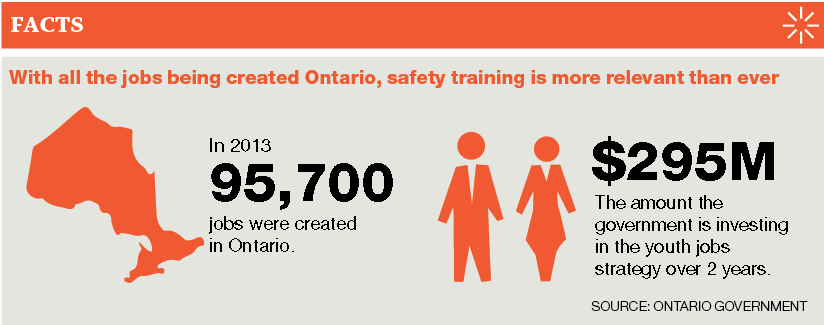Keeping New And Young Workers Safe
Industry Insight Young and new workers play a major role in Canada’s success. It is these young and new workers who are often taking on occupational roles associated with higher safety risk. For the future of our province, we must ensure these workers a long and healthy career through safety training.

Remember your first job, the thrill you felt when you were newly hired? Today, the pressure of winning that prize has grown along with the number of competitors vying for available spots. Youth unemployment stands at an all-time high, so when a young worker finally lands a position, it becomes even more critical to make sure they are successful in that role by staying healthy and safe.
Staying safe
“Young people between the ages of 15 to 24 years are four times more likely to be injured on the job during the first month than workers in other age groups,” says Elizabeth Mills, President and CEO of Workplace Safety & Prevention Services. “Their exuberance and fresh perspectives are a great asset to an employer. It’s a time in their lives when they are moving towards independence, but it’s also a time when they need to be reminded about the importance of health and safety by the actions of co-workers and the care of others.”
All too often fledgling workers begin their jobs without knowing their rights and they need extra support from employers and supervisors. “The bare minimum is not enough,” says Mills whose own organization, WSPS — in addition to offering expertise, training and consulting solutions — also oversees province-wide Young Worker Awareness Presentations.
Run by volunteers, this innovative classroom outreach program is aimed at heightening health and safety the understanding of among future workers. Since its launch in 1995, it has touched the lives of 350,000 students.
As a volunteer in the program for the past 18 years, Brian Mercer is one of 190 health and safety professionals who spend their spare time championing awareness among Ontario’s high schools. When he was 23 years old, Mercer suffered second and third degree burns to his legs while at work, an event that inspired his passion to help others.
“Volunteering with WSPS’ Young Worker Awareness is an opportunity to plant seeds in fresh minds before they go into the work environment,” says Mercer. “If I can prevent one young person from injury, my time was a great investment.”
He’ll tell you that there’s always someone in his class who shrugs their shoulders and says it won’t happen to them. But tragically, injuries and fatalities do happen. Between 2006 and 2012, 48 young workers aged 15 to 24 died in work-related incidents. During this same period, more than 58,000 young workers received injuries resulting in lost time at work.
“Young people between the ages of 15 to 24 are four times more likely to be injured on the job during the first month than workers in other age groups”
“Incidents occur when assumptions are made and knowledge gaps exist about the correct way to perform a task,” says Mills. “We must encourage young workers to ask questions. They are usually very excited when they start a new job and want to perform well, but they may need more day to day experience to know what questions to ask — or even ask about something they are not sure of.”
Reinforce good behaviour
Employers and supervisors need to foster dialogue with young workers; support them when they ask questions; and continue daily, regular communication after they’ve been trained so that safe practices become safe behaviours in the longer term. “Good behaviours need reinforcement.”
Young workers are most influenced by their co-workers and, are often deeply imprinted by the behaviours of the person who first employed them. “It’s a great opportunity for employers to encourage best practices and role model and champion health and safety among their young workers,” says Mills.
Simultaneously, young workers must own their behaviour, respecting workplace rules, asking questions, getting proper training, looking for and reporting hazards and wearing appropriate protective gear.
And, it’s not limited to the workplace. “Safety happens at work, at home, and at play,” says Mills. “Parents of young workers should have that conversation with their kids — addressing worker rights and responsibilities — including the right to refuse unsafe work.”
Mills adds that there’s an abundance of resources available through the Ministry of Labour as well as organizations such as WSPS — all focused on working with businesses to ensure employee safety and success. Recent provincial regulations aimed at achieving improved outcomes include mandatory health and safety awareness training for all new employees as well as working at heights standards and certification training for Joint Health and Safety Committees.


